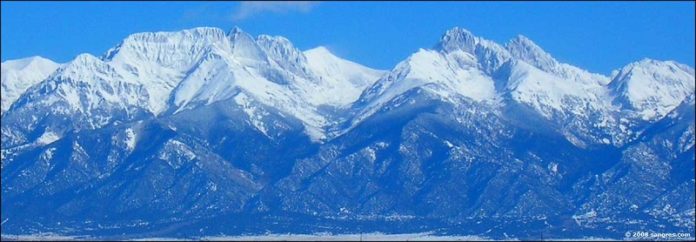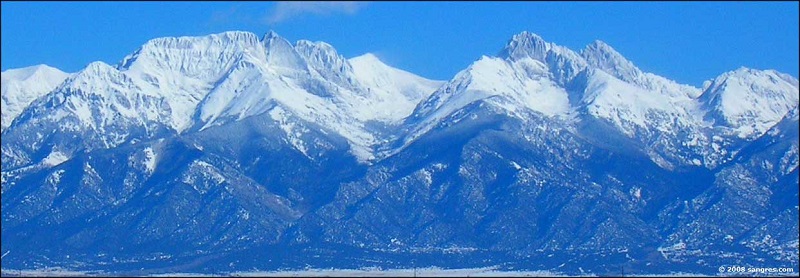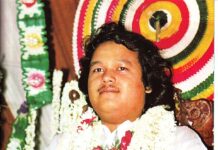
BOULDER, early summer afternoon, 1982 – The reception for the Vajradhatu and Nalanda staff in the back garden of Kalapa Court is a familiar scene: uniformed servers offer heavy trays of hors d’oeuvres, seventy or eighty guests in summer suits and dresses stand and talk, children run and play among them, wind chimes chime, and sake flows. Rinpoche sits in his wrought-iron chair on the patio in a spotless white field uniform with Yumtso (his Lhasa Apso) watching nervously from between his legs. Students approach one at a time, kneel before him and say hello, tell stories, ask for baby names, ask if they should marry so and so, ask if they should go into business, cry, laugh, and plead. In turn, Rinpoche listens, hugs, sympathizes, scolds, kisses, encourages, or ignores, while a long line of students wait to be next. Hudson Shotwell, the personal guard on duty, stands close behind Rinpoche’s chair, while I, the kusung on duty, stand ready within easy range of Rinpoche’s glance.
In the middle of that afternoon, I received a message from Larry Mermelstein that the Ta Lama had died. The Ta Lama was an elderly Tibetan gentleman who, although he was a Gelugpa and had worked closely with the Dalai Lama through much of his life, became a devoted student of His Holiness Karmapa in his later years. He had lived for several years with his family in Crestone, Colorado, a small town on the edge of the San Luis Valley in southern Colorado, about a six-hour drive from Boulder.
I delivered the message, kneeling beside his chair, “Sir, we just received word that the Ta Lama has died.” He listened but said nothing. I waited for awhile to see if any further communication was necessary and then got up and resumed my duties. A few hours later the reception was over; Rinpoche was sitting by himself in the drawing room, and I was in the kitchen getting things ready for the evening service when my beeper went off. I straightened my tie and entered the drawing room.
“Let’s go,” he said.
“Go where, Sir?”
“To see the Ta Lama,” he said, as if it were obvious and why was I asking.
“You want to go to Crestone?”
“Yes let’s go,” he said impatiently.
To me “let’s go” meant to start packing, find out who he wanted to go with him, make arrangements for where he would stay, get word to the people down there that he was on his way, cancel his schedule for the next day, etc. To him “let’s go” meant “let’s go” and he started for the door. Dapön Janowitz was there as well, and between the two of us we negotiated a few hours to make the necessary preparations. Knowing that Rinpoche sometimes disliked long car rides, the two of us described in numerous ways just how far Crestone is from Boulder. “It’s a six hour drive.” “If we leave by 8 p.m. we’ll get there at about 2 a.m. if we don’t stop at all.” “It’s like driving to RMDC three times.” He wasn’t interested in our time analysis. By about 9 p.m., we were on the road heading south, with Rinpoche and Marty in the back seat, Hudson in the driver’s seat and me riding shotgun. When we got as far Golden, about 35 minutes from Boulder, Rinpoche said, “Are we almost there?” We groaned. “No Sir, we have about five and a half hours to go.”
At some point we changed drivers, and I was behind the wheel as we drove into the San Luis Valley, a broad expanse of semi-desert surrounded by mountains and glowing under an almost full moon. Of all the times that I drove TLGD (the Mercedes) with Rinpoche in the back seat, that night stands out in my mind as the most powerful. We drove on in silence, everyone awake, Rinpoche’s presence seeming to expand beyond the car and fill the moonlit high-mountain valley. Every few miles or so we would pass by a run-down house in the middle of the desert surrounded by sage brush. Marty asked, “Sir, what do you think the people who live in these houses do out here in the middle of nowhere?” Without a moment’s pause Rinpoche answered, “I think they’re trying to be sages.”
We arrived in Crestone at about 3 a.m. and were met by Larry Mermelstein and Mitchell Levy who had arrived the previous day. A funeral ceremony was planned for the morning. After a brief rest in the only hotel in town, we woke up at about 7 a.m. and left the hotel for the Ta Lama’s house, where Rinpoche was greeted with a flurry of white scarves by several members of the Ta Lama’s family.
We were led into a small room where the Ta lama’s body was laid on a bed. Rinpoche began to chant softly in Tibetan. After a short time he paused and asked the five of us (Mitchell, Larry, Marty, Hudson, and myself) to chant the Four Dharmas of Gampopa (Larry remembers that it was the Supplication to the Takpo Kagyu). At one point he dipped his finger into a jar of something that one of the Tibetans held open for him, applied the stuff to the top of the Ta Lama’s head and continued to chant. The ceremony lasted about ten minutes, and was followed by tea in the living room and a brief chat with the family members, who were extremely grateful and reverent toward Rinpoche.
As we were leaving, walking down a little hill toward the car with Rinpoche leaning his weight on my arm, I asked him about the stuff in the jar. He said that it helps the mind to leave the body. I asked him what happens if you put that stuff on a living person. He said, “I don’t know. Let’s see!” And he started to reach for the top of my bald head with the finger that had been in the jar. I ducked and he kept trying to touch the top of my head. On some level I knew that he was just playing around, but at the same time I was genuinely afraid of what would happen if he touched my head. To make matters worse, Rinpoche would nearly lose his balance every time I ducked. He loved my predicament and laughed wildly as we jerked and struggled toward the car.
We pointed out to Rinpoche on a map that Crestone is fairly close to Dorje Khyung Dzong (DKD – a Shambhala retreat center) and asked if he would like to visit there as long as we had come all this way. Rinpoche asked how long it would take. I said about two hours at the most and the others nodded that that sounded about right. So he said that he would really like to see Ganesh, his English Mastiff that had been living at DKD for several years. So off we went.
We were right, DKD is close to Crestone … if you’re an eagle. But if you can’t fly over the Sangre de Cristo Mountains, you have to drive around them. This proved to be a bigger task than we had thought. After two hours we were still driving south on the wrong side of the mountains— almost in New Mexico—and Rinpoche was getting impatient. “Are we almost there?” Eventually we found the mountain pass that would take us to the Huerfano Valley and to DKD.

A Field of Yun Spots
As we drove along, Rinpoche said that we were driving through a field of yun* spots. He would say: “There’s one over there,” pointing out the car window to an area where we saw nothing but the arid terrain dotted with scrub pines and sage. At one point he said, “That one over there is a false yun spot.” And then he pointed out another yun spot and we asked if we could stop and collect some of the yun. He said that would be fine. So we pulled over and Rinpoche pointed out a clump of scrubby trees surrounded by tall, reddish, reed-like plants a hundred yards or so from the road. He said that we would find a clearing in the middle of the trees and in the middle of the clearing we would find the yun. Marty stayed with Rinpoche while Hudson and I set off running with a shovel and a sack toward the trees. When we got there, we found the open area just as he had said. In the middle of the clearing was a circle of gray-white soil the consistency of dry clay. We returned with a full sack and showed it to Rinpoche. He said that it was yun.
We stopped again to collect yun from a spot on the side of the road near DKD. This time the ground was harder. We could only scrape a little yellowish powder off the surface. When we showed it to Rinpoche he said that it was second class yun and that the first sample was third class yun. Marty asked what first class yun looked like. Rinpoche answered that he had only seen first class yun in Tibet and Nova Scotia.
The caretakers’ house was empty when we drove up. It looked as though no one was around. We drove around DKD looking for Ganesh. At one point we drove up to one of the retreat cabins. It was about a month before Abhisheka so the retreat cabins were all full of people doing Guru Yoga retreats. Rinpoche had us stop in front of the cabin called Tiger and sent me in to see who was there. I startled Katherine Campbell who had just arrived and who was more than a little surprised to find a uniformed kasung at the door. “There is someone here to see you,” I said. She was even more surprised to see the Mercedes with Rinpoche sitting in the back seat. She went out to say hello and had a brief pre-guru-yoga-retreat audience with her guru. We stayed at DKD for a few hours. Ganesh eventually showed up and had an enthusiastic reunion with his master.
The Drive Home
By early evening we were cruising north on the interstate with Rinpoche in the back saying, “Drive Fast!” which I did. There was very little traffic and the Mercedes handled nicely at high speeds. Rinpoche snored softly in the back seat.
As we were nearing the crest of a small hill about an hour south of Denver, Rinpoche suddenly woke up, sat forward in his seat and mumbled something. We all leaned toward him to hear what he was saying. As soon as we reached the top of the hill, we could see a State Patrol car on the side of the road and, as we passed, we could see that the officer was pointing a radar gun out the window. There was no doubt in my mind that I was busted. I slowed down and prepared to be pulled over; but when I looked in the rear view mirror, expecting to see flashing blue lights, I saw the cruiser still sitting there and the radar gun still pointing across the road.
As soon as he had spoken, Rinpoche slumped back into his seat and was once again fast asleep. Marty woke him up saying, “Excuse me sir, what did you say just now”? Rinpoche repeated what he had said. It was a mantra beginning with OH AH HUM, but none of the three of us heard it clearly.
“Why did you say that?,” asked Marty.
“We needed a gap,” Rinpoche replied and then fell asleep again.
We continued on through Denver, driving a bit slower, and then north to Boulder and a momo dinner at Mr. Lee’s restaurant.











